MARIANI’S
Virtual Gourmet
MAY 10, 2015
NEWSLETTER

HAPPY
MOTHER'S DAY!
IN THIS ISSUE
DINING AROUND DALLAS
By John Mariani
JAMES BEARD AWARDS 2015 KEEP
A DELICATE BALANCE
By John Mariani
NEW YORK CORNER
Mastro's
By John Mariani
❖❖❖
DINING AROUND DALLAS
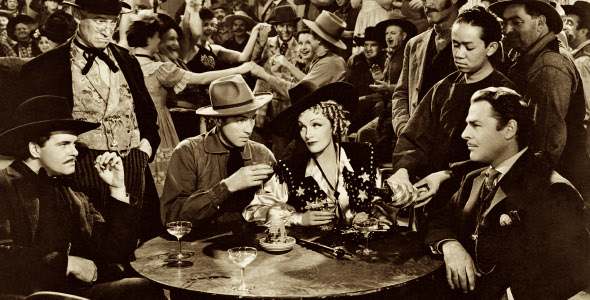
James Stewart, Marlene Dietrich and Brian Donlevy in "Destry Rides Again" (1939)
By John Mariani
The
often myopic East Coast-based food media
who never set foot in Dallas continue to believe
that Tex-Mex and barbecue
pretty much sum up the city’s gastronomy, so they
thereupon focus coverage on
those eateries alone. But, if they’d
actually visit, they would find Dallas to be one
of the most diverse food
cities in America, certainly ranking in culinary
importance with Chicago,
Boston and Washington, and surpassing Seattle,
Portland and Charleston in
breadth and depth of offerings.
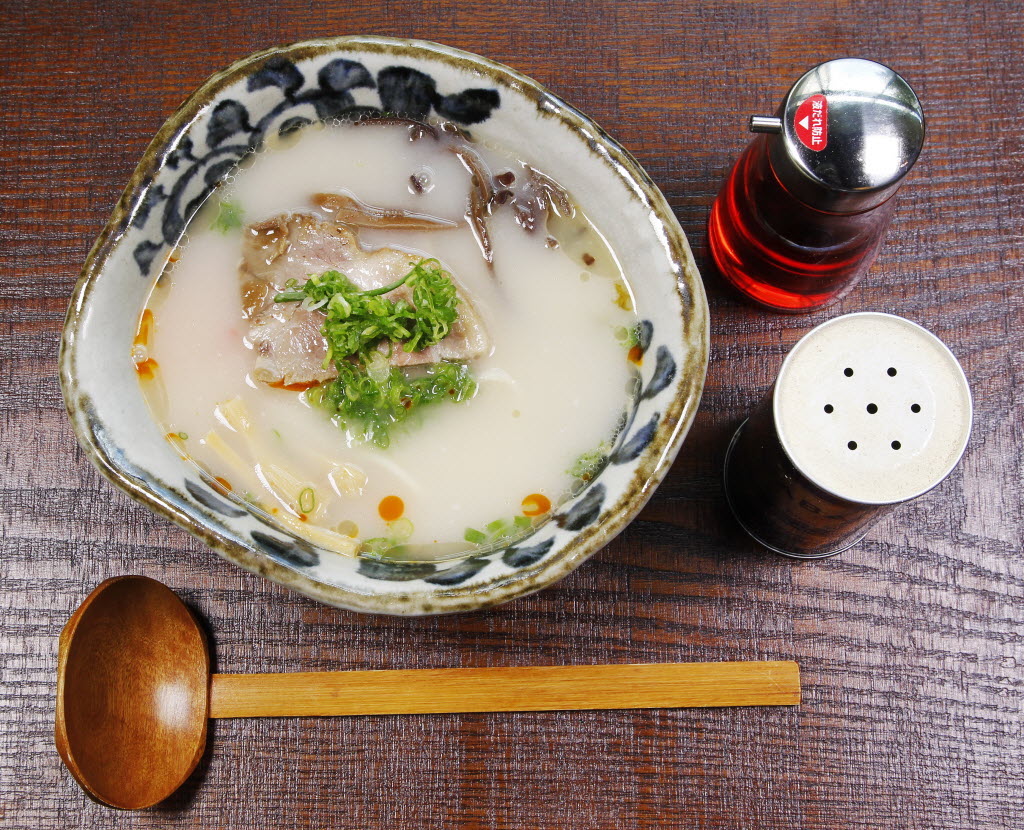 To be sure,
good Tex-Mex and barbecue are to be
found in Dallas, but the upscale and the ethnic
dining scenes thrive right
beside them, from classic high-end restaurants like
the French Room at the
Adolphus and Fearing’s in the Ritz-Carlton to a
modern Japanese restaurant like
Tei-An (left) and the
truly Mexican Ruth’s Tamale House; from indigenous
steakhouses
like Al Biernat’s to cozy bistros like Boulevadier
and the beloved 1957
landmark Zodiac Room in Neiman-Marcus.
Oddly, the city lacks anything like a
first-rate Italian restaurant.
To be sure,
good Tex-Mex and barbecue are to be
found in Dallas, but the upscale and the ethnic
dining scenes thrive right
beside them, from classic high-end restaurants like
the French Room at the
Adolphus and Fearing’s in the Ritz-Carlton to a
modern Japanese restaurant like
Tei-An (left) and the
truly Mexican Ruth’s Tamale House; from indigenous
steakhouses
like Al Biernat’s to cozy bistros like Boulevadier
and the beloved 1957
landmark Zodiac Room in Neiman-Marcus.
Oddly, the city lacks anything like a
first-rate Italian restaurant.
A return trip to Dallas last
month reminded me
of the rich panoply of engaging spots from breakfast
through dinner.
I was so happy to get back to LaDuni (with
three locations), which
serves the best pastries in town--the tres
leches cake is devastatingly delicious--along
with bountiful dishes like
eggs Benedict and honey ham in a giant popover
($11.45), a
tostada filled with eggs, bacon,
black beans, salsa and potato called migas
($10.50),
and
enchiladas
suizas with Gruyère cheese and basmati rice
($14.25). As
appealing as the food is, owners
 Dunia Borga
(Columbia-born) and her husband Espartaco (a
Spaniard) lend their thousand-watt
personalities to their restaurants. Dunia (right) was
selected “Best Pastry Chef” by D Magazine,
and, with Chef Julia Lopez
assuring consistency every day, La Duni is easily
one of the most popular
restaurants in Dallas.
Dunia Borga
(Columbia-born) and her husband Espartaco (a
Spaniard) lend their thousand-watt
personalities to their restaurants. Dunia (right) was
selected “Best Pastry Chef” by D Magazine,
and, with Chef Julia Lopez
assuring consistency every day, La Duni is easily
one of the most popular
restaurants in Dallas.
One of the best of the city’s new restaurants, CBD
Provisions (below), is set within the city’s
best modern hotel, The Joule, whose striking design,
lighting and artwork would
be unique in any city. CBD, though lacking the same
high style, serves hearty
breakfasts, lunch and dinner out of a long, open
kitchen supervised by Chef
Richard Blankenship, who has a canny way of spinning
traditional Texas and
American dishes with just enough panache to make
them taste brand new.
These include buttermilk rye pancakes
with bourbon maple syrup ($11) at breakfast, and, at
dinner, a dramatic table
presentation of a whole Berkshire pig’s head with
crisp skin and custard-like flesh,
enhanced with roasted tomatillo salsa and hot
tortillas. CBD
also has a wide-ranging artisanal
beer collection worth perusing.
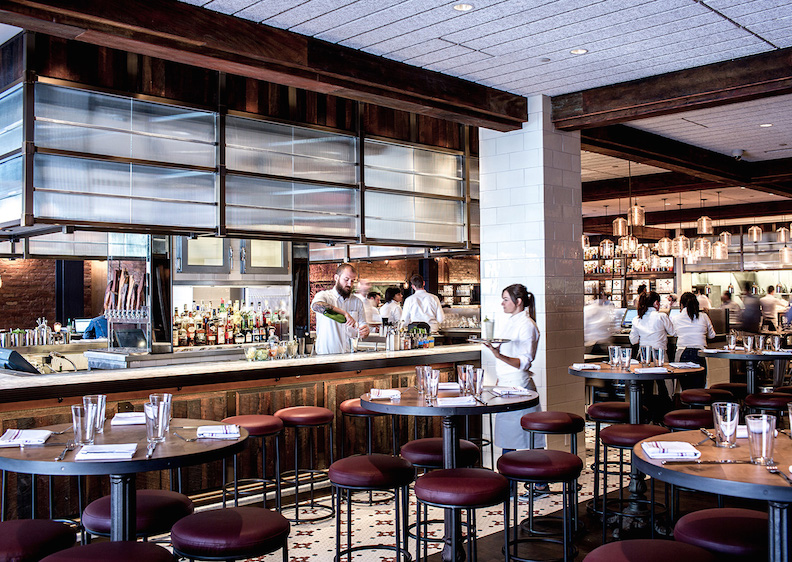 At
the high end of Dallas dining, the
restaurant at the Mansion
on Turtle
Creek (below)
has had four decades to establish itself as a place
for the big
splurge, although it’s now a far more casual place
than it used to be and
thereby lost much of its previous glamour. French Chef Bruno Davaillon
continues the Mansion’s
tradition of refined modern global cuisine, evident
in dishes like his ahi tuna
with gazpacho, peas and tuna sauce ($20) and his
scallops in coconut broth with
lemon verbena and mussels ($44).
The Mansion’s famous tortilla soup remains on
the menu always.
At
the high end of Dallas dining, the
restaurant at the Mansion
on Turtle
Creek (below)
has had four decades to establish itself as a place
for the big
splurge, although it’s now a far more casual place
than it used to be and
thereby lost much of its previous glamour. French Chef Bruno Davaillon
continues the Mansion’s
tradition of refined modern global cuisine, evident
in dishes like his ahi tuna
with gazpacho, peas and tuna sauce ($20) and his
scallops in coconut broth with
lemon verbena and mussels ($44).
The Mansion’s famous tortilla soup remains on
the menu always.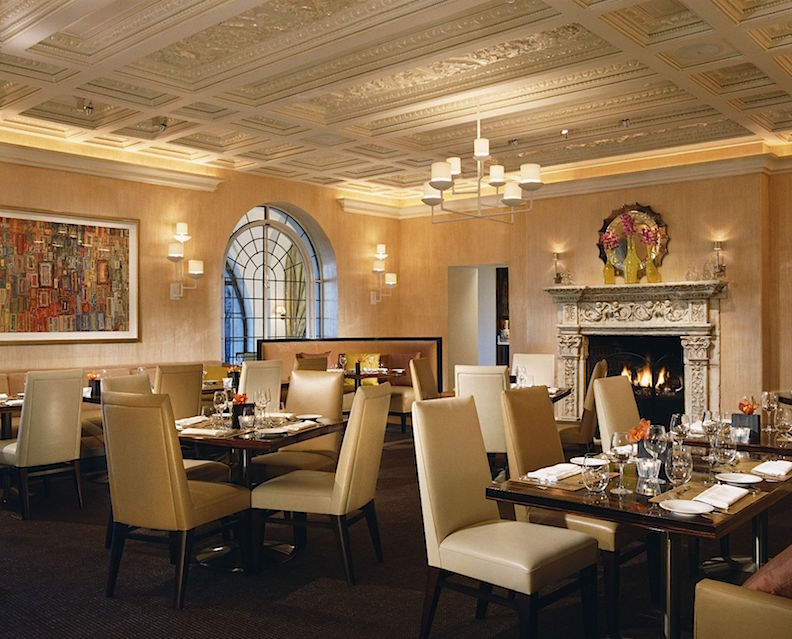
I
can say without fear of contradiction that there is
no more seriously committed
steakhouse in America than Knife,
an
expansive, handsome, open-kitchen dining room where
Chef John Tesar is
pioneering aging techniques for his superlative
dry-aged beef (below),
with one cut
spending 240 days in a temperature-controlled locker
to achieve a remarkable,
deep flavor in the meat, which is sold at $80 the
inch! There are also slabs of
crispy pork belly with collard greens ($18), spicy
blood sausage ($29), and a
tasting of five bacon varieties ($14).
Knife is setting a standard that other
steakhouses around the country
will be taking a good look at to see how they might
measure up. And since Tesar and his backers have
expansion on their minds, the competition is going
national.
 Of
course, there really is every reason to search out
good barbecue in Dallas,
especially since the once heralded Sonny Bryan’s
Bar-B-Que stand has sadly lost
all its luster after a corporate takeover. My new favorite is Smokey
John’s Bar-B-Que
(below),
not just for its exceptional ribs ($11.95) and
smoked brisket
($15.95), but for a wide variety of soul food dishes
like hearty baked chicken
($8.95), fried catfish, sweet potatoes, cornbread,
and the terrific hot garlic
sausage ($13.95) no one else is doing.
What’s more, every Tuesday there is joyously
thrilling gospel singing
and a prayer meeting, so you’ll not only leave well
fed but probably singing "halleluiah!"
Of
course, there really is every reason to search out
good barbecue in Dallas,
especially since the once heralded Sonny Bryan’s
Bar-B-Que stand has sadly lost
all its luster after a corporate takeover. My new favorite is Smokey
John’s Bar-B-Que
(below),
not just for its exceptional ribs ($11.95) and
smoked brisket
($15.95), but for a wide variety of soul food dishes
like hearty baked chicken
($8.95), fried catfish, sweet potatoes, cornbread,
and the terrific hot garlic
sausage ($13.95) no one else is doing.
What’s more, every Tuesday there is joyously
thrilling gospel singing
and a prayer meeting, so you’ll not only leave well
fed but probably singing "halleluiah!"
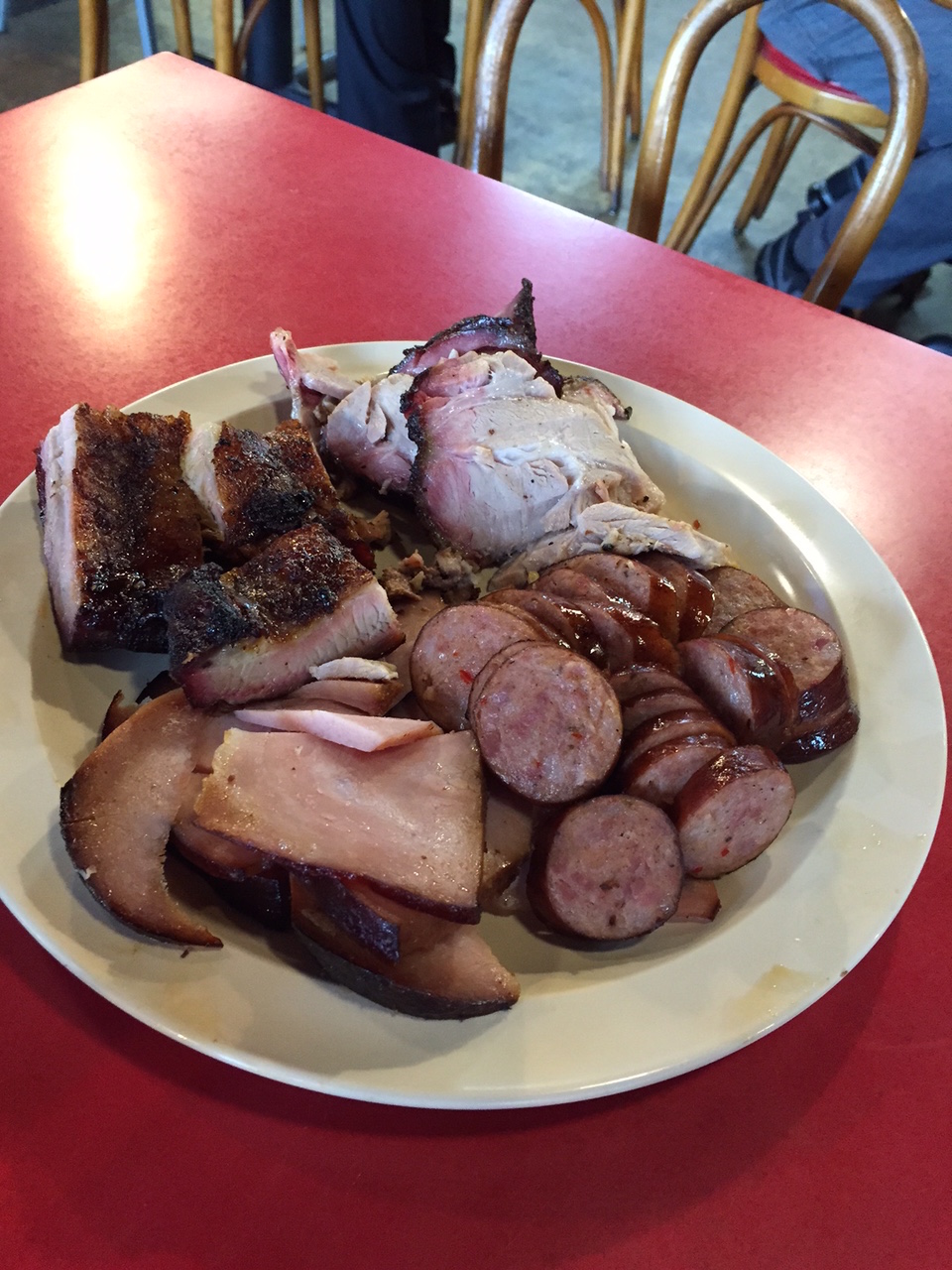
To
get a sense of the way Dallas’s dining
scene has developed, it would make sense to eat at
each of Chef Stephan Pyles’
restaurants. Pyles was one of the pioneers of “New
Texas Cuisine” back in the
‘80s, and his restaurants are always evolving. The
newest, San Salvaje (“wild saint”), is a
casual, colorful, sexy restaurant
and bar with an outdoor patio where you can sip a
well-made margarita and nosh
on items like Ecuadorian potato cake with bacon and
egg ($10) and fried squid
tacos with preserved lemon ($8), or larger plates of
fried whole branzino with
pickled green beans and a mango-habanero mojo ($24).
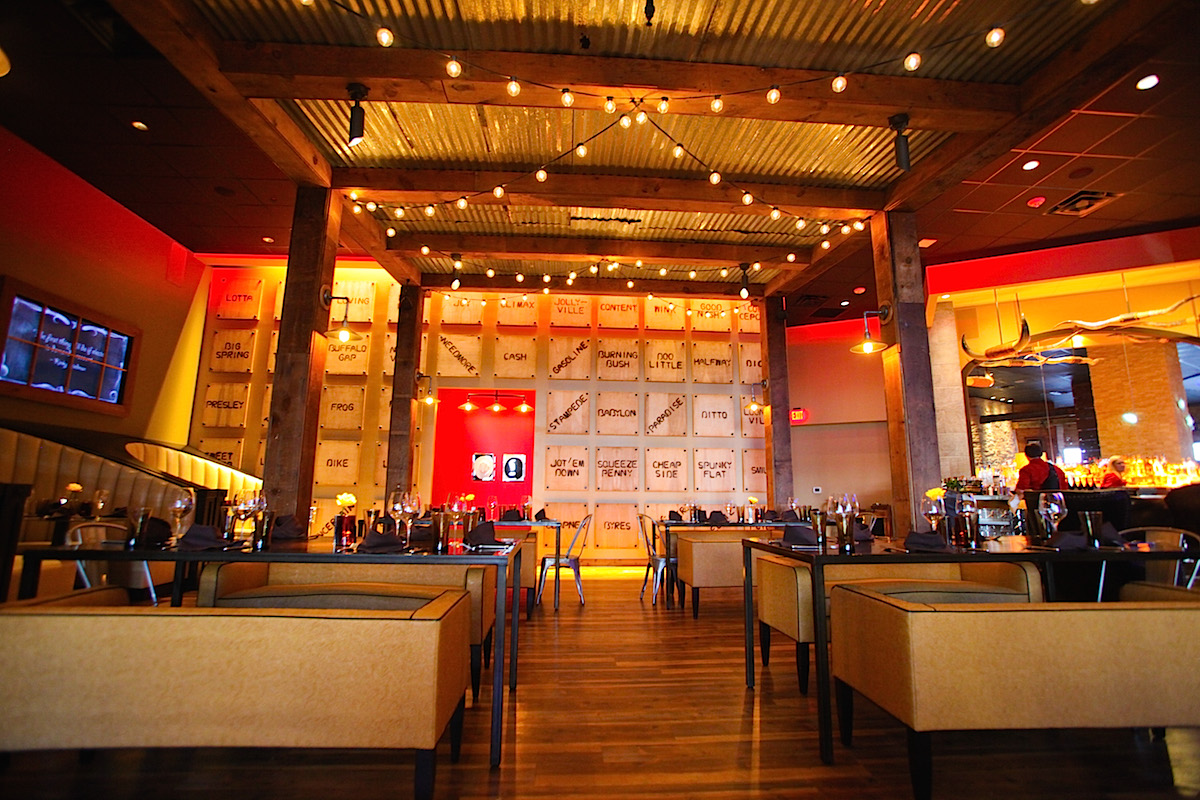 At Stampede 66
(left),
you’ll find a vast dining room of fascinating
western art incorporating steer
horns and barbed wire as well as a TV showing
western movies.
Here Pyles is re-interpreting Texas
cooking with dishes like Pedernales chili ($12),
sweet potato and wild boar
tamales ($12), and a rich warm brownie with
Snickers-laced ice cream and a Dr Pepper float
($10). It’s a place people never
seem to be in a rush to leave.
At Stampede 66
(left),
you’ll find a vast dining room of fascinating
western art incorporating steer
horns and barbed wire as well as a TV showing
western movies.
Here Pyles is re-interpreting Texas
cooking with dishes like Pedernales chili ($12),
sweet potato and wild boar
tamales ($12), and a rich warm brownie with
Snickers-laced ice cream and a Dr Pepper float
($10). It’s a place people never
seem to be in a rush to leave.
Pyles is now in the process of
relocating his fine dining room named
Stephan Pyles, so I hope to return in the fall when
it’s up and running strong.
I could not end any
report on Dallas without noting the opening of a
remarkable place called Cafe Momentum,
where director Chad Houser, chef de
cuisine Eric Shelton and sous-chef Justin Box are
offering young people in
pre-release detention programs a chance to learn
culinary skills and every
aspect of the restaurant business, working side by
side with established chefs
in town. In contract with the Dallas County Juvenile
Justice Department, they
opt to take on youth deemed at highest risk for
incarceration, and their
recidivism rate for program graduates is
dramatically below others in the
juvenile justice system.
Café
Momentum gives these young men a cultural context
within a world they know
little about, and, from meeting several of these
interns, I sensed that for
many this was the best thing ever to happen to them
and the first shot at a
redemptive livelihood.
And we get to
feast on their efforts in
multi-course meals that range from shrimp and grits
beignets with tasso aïoli
($11) and smoked fried chicken with biscuits,
braised cabbage and mashed
potatoes ($21) to pork loin with cider beans,
mustard seeds and apples ($20),
ending off with fried apple pie with smoked cheddar
ice cream and cinnamon
walnuts ($8).
On
Momentum’s wall are
written the wonderful words “EAT. DRINK.
CHANGE LIVES”
and “Welcome to Our Home.” Both are
sentiments of Dallas hospitality at its most
endearing and effective.
❖❖❖
 JAMES BEARD AWARDS
2015
JAMES BEARD AWARDS
2015 KEPT A DELICATE BALANCE
By John Mariani
The
James Beard Awards handed out this past
Monday in Chicago were a good deal more balanced
than I had expected. On the basis of so many of
the
nominees, it appeared the judges--a wide array of
food authorities across the
USA--might be inclined toward the most media-hyped
chefs who have made so many
other lists for little more than attempts to seem
cutting edge.
But, appearing right along with
them--and winning most of the categories--far more
established fine dining
restaurants were to be found, and that is all to
the good at a time when
culinary novelty too often trumps enduring
excellence.
The
regional
awards are the toughest to predict because, quite
frankly, so few in so many
regions are known at all outside their respective
cities. In the national categories,
like Restaurant of the Year and Outstanding Pastry
Chef, the nominees are
supposed to be "national standard-bearers," which,
of course, favors
chefs in New York, Chicago, Los Angeles, and San
Francisco, especially since
the guidelines insist that judges must swear to
have actually eaten at the
restaurants in the recent past. As
most of the judges are food critics who rarely get
out of the cities they write
about, this makes the prospect of a chef from
Boulder, Colorado, or Cave Creek,
Arizona, obtaining sufficient votes slim.
Having once been on the Restaurant Awards
Committee for several years
(two as its chairmen), I continue to commend the
members for their hard, honest
work. I am often asked how a chef or restaurant
can influence the voting, and
the answer is, they can't--shy of a publicity
barrage that brings a
little-known chef to the attention of the
committee.
That
said, and with the
acknowledgement that I have not eaten at every
restaurant on the list, here are
some notes on the winners of the 2015 awards.
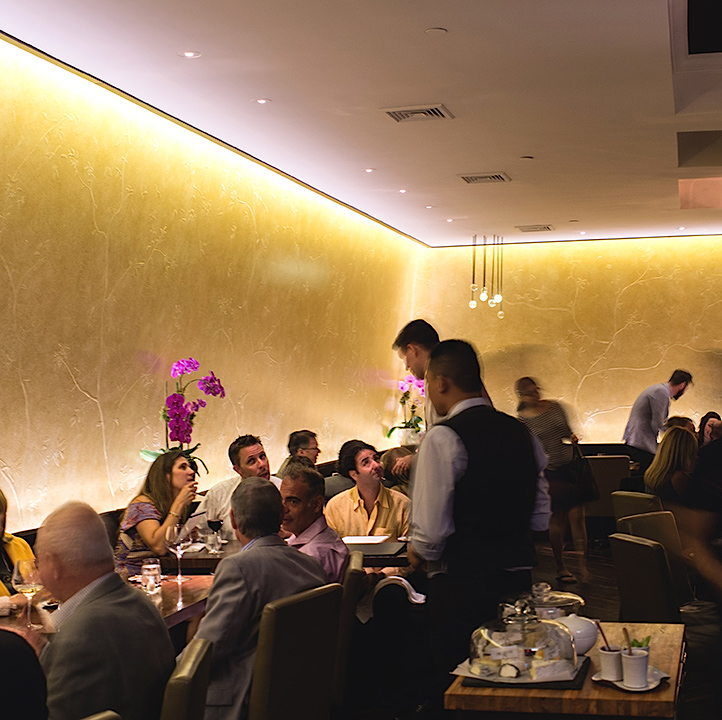 Best New Restaurant:
Bâtard, NYC (left)—Excellent
choice,
not least because 20 years ago, restaurateur Drew
Nieporent pioneered
modern French cuisine in once-derelict TriBeCa and
encouraged his
chefs--currently Marcus Glocker--to let that
cuisine evolve. This is a win for
refinement, urban gentility and all-around concern
for every aspect of dining
out.
Best New Restaurant:
Bâtard, NYC (left)—Excellent
choice,
not least because 20 years ago, restaurateur Drew
Nieporent pioneered
modern French cuisine in once-derelict TriBeCa and
encouraged his
chefs--currently Marcus Glocker--to let that
cuisine evolve. This is a win for
refinement, urban gentility and all-around concern
for every aspect of dining
out.
Outstanding
Chef: Michael Anthony,
Gramercy Tavern, NYC—Very
well deserved for a chef able to
turn out exuberantly personalized cuisine for such
a huge number of demanding
diners each night. This is still one of
restaurateur Danny Meyer’s finest
efforts, and more than a decade in business has
not dulled the sharpness of the
enterprise.
Outstanding Restaurant: Blue
Hill at
Stone Barns, Pocantico Hills, NY (below)—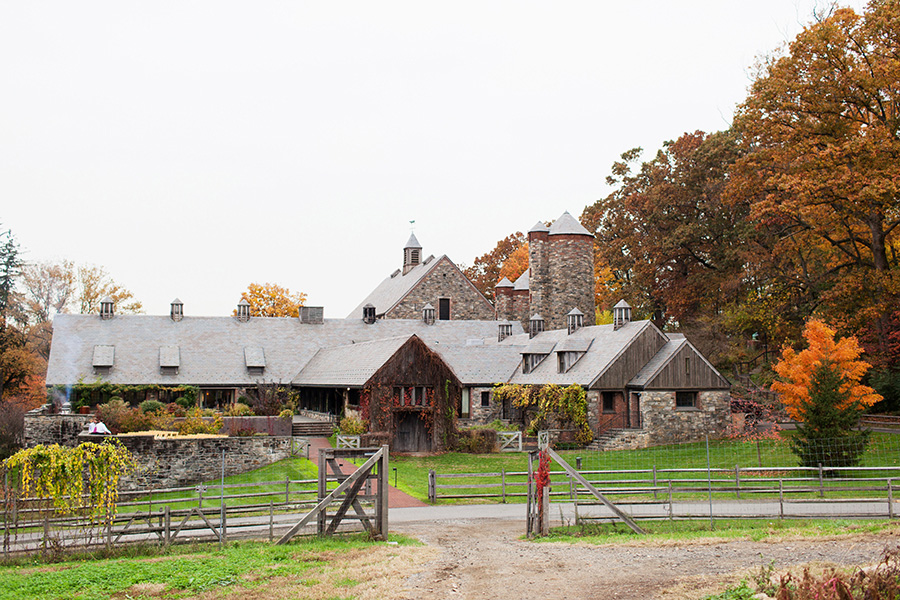 Despite
the price
of a meal at Blue Hill at Stone Barns, the small
portions of mostly
vegetable-based courses, and the exorbitant wine
list, this is a unique
restaurant in terms of its beauty, its setting (on
a Rockefeller farm estate on
the Hudson River) and for its seminal commitment
to the principles of
sustainable agriculture and local ingredients—most
grown right on the property.
Despite
the price
of a meal at Blue Hill at Stone Barns, the small
portions of mostly
vegetable-based courses, and the exorbitant wine
list, this is a unique
restaurant in terms of its beauty, its setting (on
a Rockefeller farm estate on
the Hudson River) and for its seminal commitment
to the principles of
sustainable agriculture and local ingredients—most
grown right on the property.
Outstanding
Restaurateur: Donnie
Madia, One Off Hospitality Group (Blackbird,
Avec, The Publican, etc),
Chicago—A
solid
choice for a restaurateur who shook up the
once-staid Chicago dining
scene by showing that a casual setting can be the
backdrop for wonderful
cooking and was an early entry in the gastro-pub
trend of the early part of the
last decade.
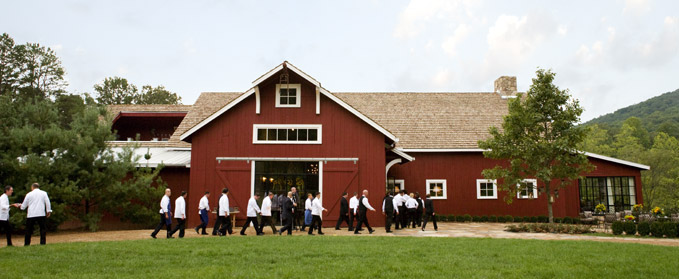 Outstanding Service: The Barn at
Blackberry
Farm, Walland, TN (left)--The
rarity, still, of the unstinting
commitment to service at this stunning farmland
restaurant in the middle of
nowhere is testament to American hospitality at
its highest, and the award is a
recognition that congenial service is still
respected and expected by the more
discerning dining public.
Outstanding Service: The Barn at
Blackberry
Farm, Walland, TN (left)--The
rarity, still, of the unstinting
commitment to service at this stunning farmland
restaurant in the middle of
nowhere is testament to American hospitality at
its highest, and the award is a
recognition that congenial service is still
respected and expected by the more
discerning dining public.
Outstanding Wine Program: A16, San
Francisco—With
the exception of nominee Bern’s
Steak House in Tampa, which has the country’s
largest wine list and a unique
program for serving it, this was a fairly modest
list. For
its championing of lesser-known
Italian regional wines, A16 deserves wholehearted
commendation, however.
Best Chefs in
America
Great
Lakes: Jonathon Sawyer,
Greenhouse Tavern, Cleveland—A
much more
reasonable choice than the chef many expected to
win—Curtis Duffy of the
molecular/modernist Chicago school—especially
since Greenhouse Tavern is in
always-ignored Cleveland.
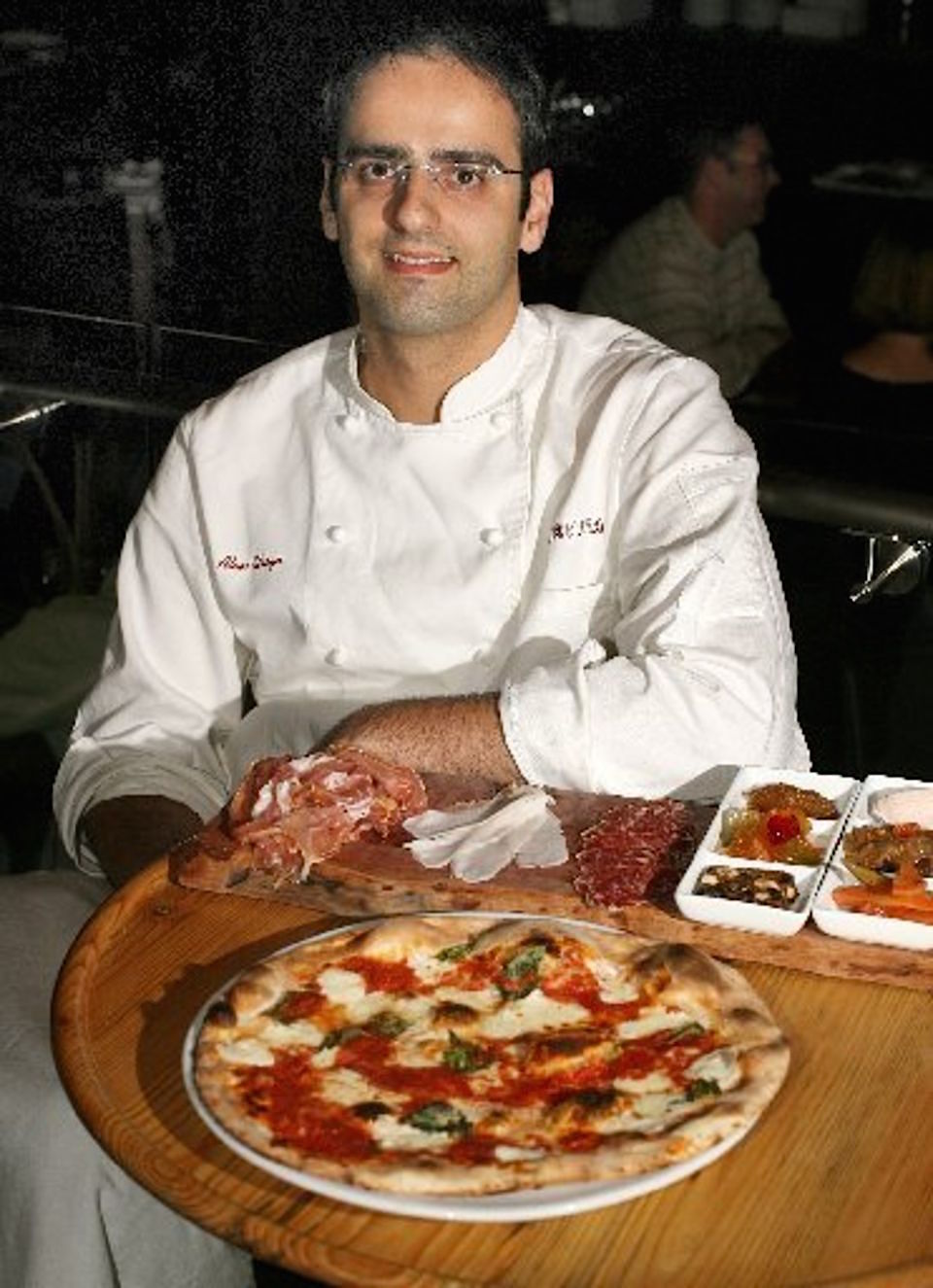 Mid-Atlantic:
Spike Gjerde, Woodberry
Kitchen, Baltimore—This
was a fine choice, for Gjerde
is not just a restaurateur and chef but someone
who has butcher shop
credibility and an admirable focus on curing and
aging the products he uses.
Also good to see Baltimore get the attention to
the exclusion of some mediocre
Philadelphia restaurants among the nominees.
Mid-Atlantic:
Spike Gjerde, Woodberry
Kitchen, Baltimore—This
was a fine choice, for Gjerde
is not just a restaurateur and chef but someone
who has butcher shop
credibility and an admirable focus on curing and
aging the products he uses.
Also good to see Baltimore get the attention to
the exclusion of some mediocre
Philadelphia restaurants among the nominees.
South:
Alon Shaya, Domenica, New
Orleans (left)--Shaya
brought authentic Italian
food to New Orleans without kowtowing to dated
ideas of Creole-Italian cookery
still found around town. He
mastered pizza-making, his pastas are sumptuous
and respect tradition, and his
sincerity about what he does shows in every dish.
New
York City: Mark Ladner, Del Posto—Everyone
knows
that Ladner has been the true eminence of the
kitchen at Del Posto, not
co-owner Mario Batali, and Ladner richly deserves
recognition for his knowledge
of Italian cuisine and how to push it just so far
without corrupting its
essential simplicity. The other nominees were
fairly weak by comparison, though
there are plenty of unlisted others who might have
given Ladner a run for his
money.
Southeast:
Jason Stanhope, FIG,
Charleston, SC—Like
Mark Ladner, Stanhope works in
the shadow of FIG owner/chef Mike Lata, though
Lata is fully supportive of his
executive chef. The only other well-known
contender on the list was the
first-rate chef/owner Steven Satterfield of Miller
Union in Atlanta, so
Stanhope earned his stripe.
Southwest:
Aaron Franklin, Franklin
Barbecue, Austin—This
was a very unfortunate choice,
not because Franklin is not one of America’s
finest barbecue cooks, but because
that is all
he really does out of his
cramped, no-reservations ‘cue stand in Austin. All the other nominees--Kevin
Binkley, Binkley’s, Cave
Creek, AZ; Bryce Gilmore, Barley Swine, Austin;
Hugo Ortega, Hugo’s, Houston;
Martín Rios, Restaurant Martín, Santa Fe; and
Justin Yu, Oxheart, Houston--show
both depth and breadth in their kitchens and
service. Franklin 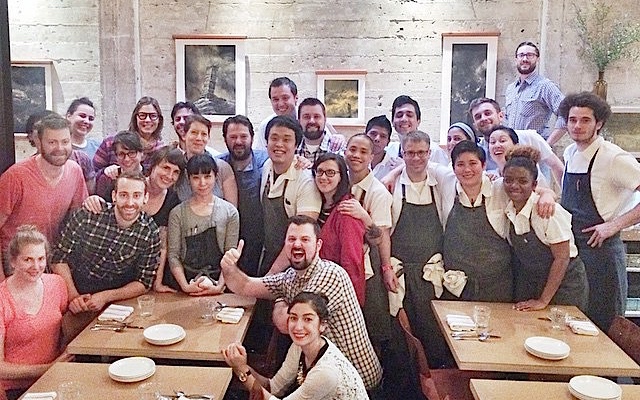 is out of his depth among them.
is out of his depth among them.
West:
Stuart Brioza and Nicole
Krasinski, State Bird Provisions, San Francisco
(right)—I
might have thought Michael Cimarusti of Providence
in L.A. or Corey Lee of Benu
in San Francisco would have taken this category,
but Brioza and
Krasinski are outstanding in what
they do, which is a free-form version of
California dim sum.
Humanitarian
of the Year: Michel
Nischan, Co-founder, CEO and President of
Wholesome Wave, Westport, CT—Very,
very
well deserved.
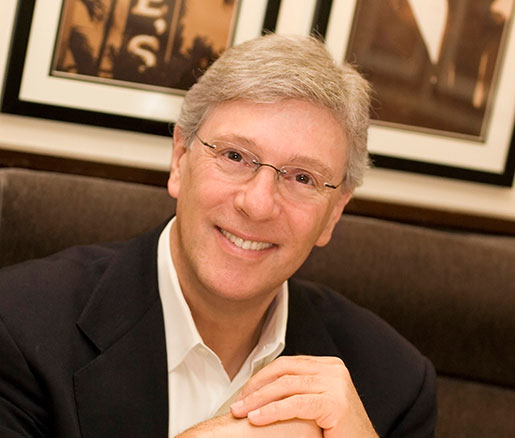
Lifetime Achievement Award: Richard
Melman, Lettuce Entertain You Enterprises, Chicago (left)—Finally!
One of America’s finest, creative. and
most congenial restaurateurs whose own history is
inextricable from our nation's gastronomic
history.
❖❖❖
By John Mariani
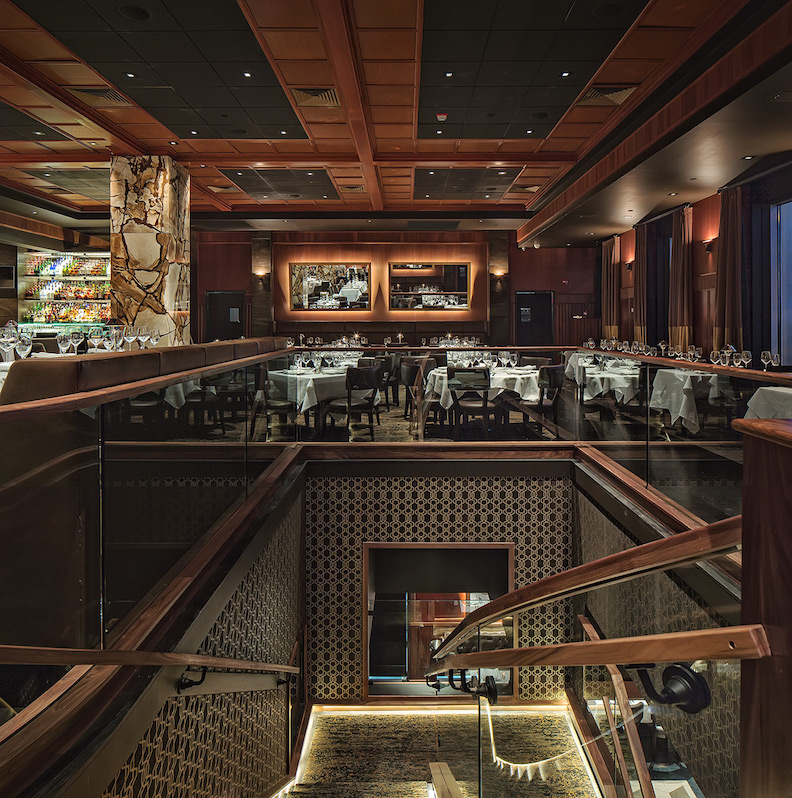 MASTRO'S
STEAKHOUSE
MASTRO'S
STEAKHOUSE1285 Avenue of the Americas (near 53rd Street)
212-459-1212
www.mastrosrestaurants.com
Toss
a
T-bone in any direction around Rockefeller
Center and you’ll likely hit a
steakhouse: Quality Meats, Strip House, Hunt
& Fish Club, Ruth’s Chris,
Empire Steakhouse, Morton’s, Palm,
Capital Grille, STK, Shula’s, Bobby Van’s, NYY
Steak, Bull & Bear, Michael
Jordan, Del Frisco’s, Del Frisco’s Grill, all
smack in midtown, all with more
or less the same menu, the same prices for
steaks and chops, and, increasingly,
cordial service designed to make regulars of
consumers
who have an embarrassment of choices in
the matter.
Most are
either local or national chains,
which depend on the loyalty of patrons faithful to
the original Ruth’s Chris in
New Orleans or the Shula’s in Coral Gables who
will search out their branches
in other cities.
The newest entry,
replacing a McCormick & Schmicks, is Mastro’s,
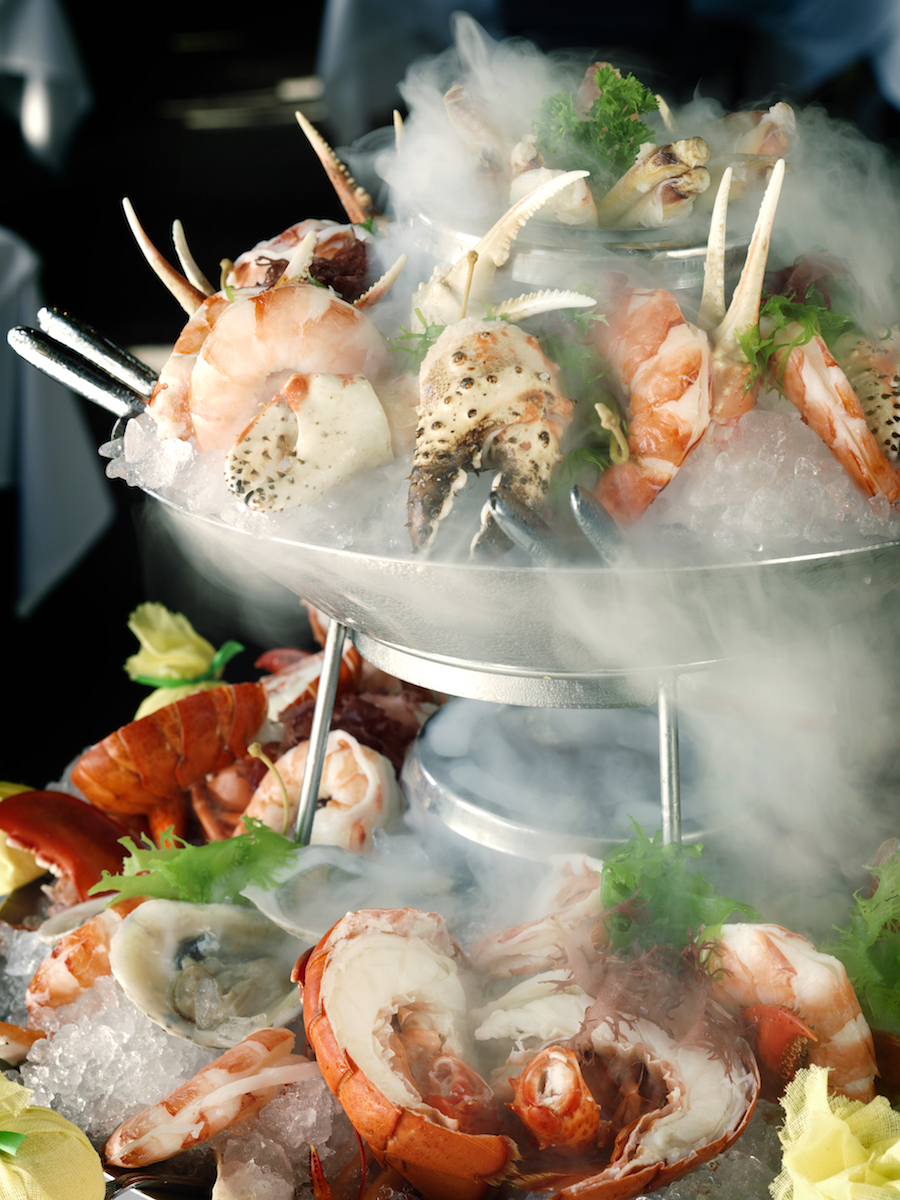 part of a 12-link
chain that
began in Scottsdale, Arizona, and now has branches
in California, Illinois, and
Nevada; this is the first one to open on the East
Coast (last November), with
DC to debut this month. All
have the same menu and all offer live and canned
music played at an extremely
high decibel level; décors differ from city to
city.
part of a 12-link
chain that
began in Scottsdale, Arizona, and now has branches
in California, Illinois, and
Nevada; this is the first one to open on the East
Coast (last November), with
DC to debut this month. All
have the same menu and all offer live and canned
music played at an extremely
high decibel level; décors differ from city to
city.
The décor
in NYC is swanky, low-lighted, set on two levels,
which its website insists was
chosen to represent “the authenticity of New York
City,” with bars made of
bronze satin quartzite, dark
mahogany woodwork, stained wood flooring, marble
columns, and trompe l’oeil
patterns set within the floors and walls.
I’m not sure what’s so authentic about such
design elements, but it
makes for a good-looking space with lots of
polish, and for a restaurant open
for short a time, its management and wait staff
are pros, many of them veterans
of other steakhouses in town.
The
spacious tables are set with two
tablecloths, which soak up some of the noise, but
it is extremely difficult to
have a conversation owing to the loudness of the
thumping music upstairs; those
who complain are offered the option to dine in the
dreary downstairs section,
usually used for private parties. I did ask for
the music to be turned down and
the manager graciously did so. Black napkins are
offered for those in dark
clothes. Plates
come out nice and
hot. Oversized wine glasses, by comparison with
many competitors’, could be of
better quality.
The two-foot-tall tower
of seafood is impressive, not least for the
dramatic billowing mist of dry ice
pouring out of it.
The menu
invites you to “create your own selection” of
seafood on the tower, but our
table left it to the waiter to decide.
What arrived was an abundant display of
jumbo shrimp, crab, lobster,
crab legs and oysters. But be aware you will be
charged by the selection, so
that the price can soar, with crab cocktail $28,
crab legs $34, and lobster
cocktail $35.
Ours, for four
people, came to an eyebrow-raising $207.
 All
of the steak cuts we
tried were first-rate. All, except an 8-ounce
Japanese wagyu strip ($145), were
USDA Prime: bone-in 18-ounce Kansas City strip
($58) and bone-in 22-ounce
ribeye ($59) were all sliced and deftly portioned
out at the table.
Prices are comparable to other
steakhouses in the neighborhood.
All
of the steak cuts we
tried were first-rate. All, except an 8-ounce
Japanese wagyu strip ($145), were
USDA Prime: bone-in 18-ounce Kansas City strip
($58) and bone-in 22-ounce
ribeye ($59) were all sliced and deftly portioned
out at the table.
Prices are comparable to other
steakhouses in the neighborhood.
Mastro’s also
serves
whole lobsters from two to four pounds. We ordered
the latter, and I asked, if
they were going to crack the shells and remove the
meat, that it be done when
all the other entrees arrived so that the lobster
would not get cold. Our
waiter said he would do the job at our table but
instead a plate of lobster
meat only was placed before us, and, from the size
of the claw and tail meat,
it didn’t seem that this began as a four-pounder. Neither were the carcass,
walking legs or uropods of the tail
on the plate--many people do enjoy
the tomalley and all the rest--and, at a whopping
$140, this was a
disappointment.
Creamed spinach ($14)
and an impeccably cooked, split and buttered
one-pound Idaho potato ($13) were
delicious.
The signature warm butter
cake ($16) was a triumph of decadent goodness (right), the
chocolate sin cake ($10) was
thick and fudgy, but in the city that invented the
Italian and Jewish-style
cheesecakes, Mastro’s 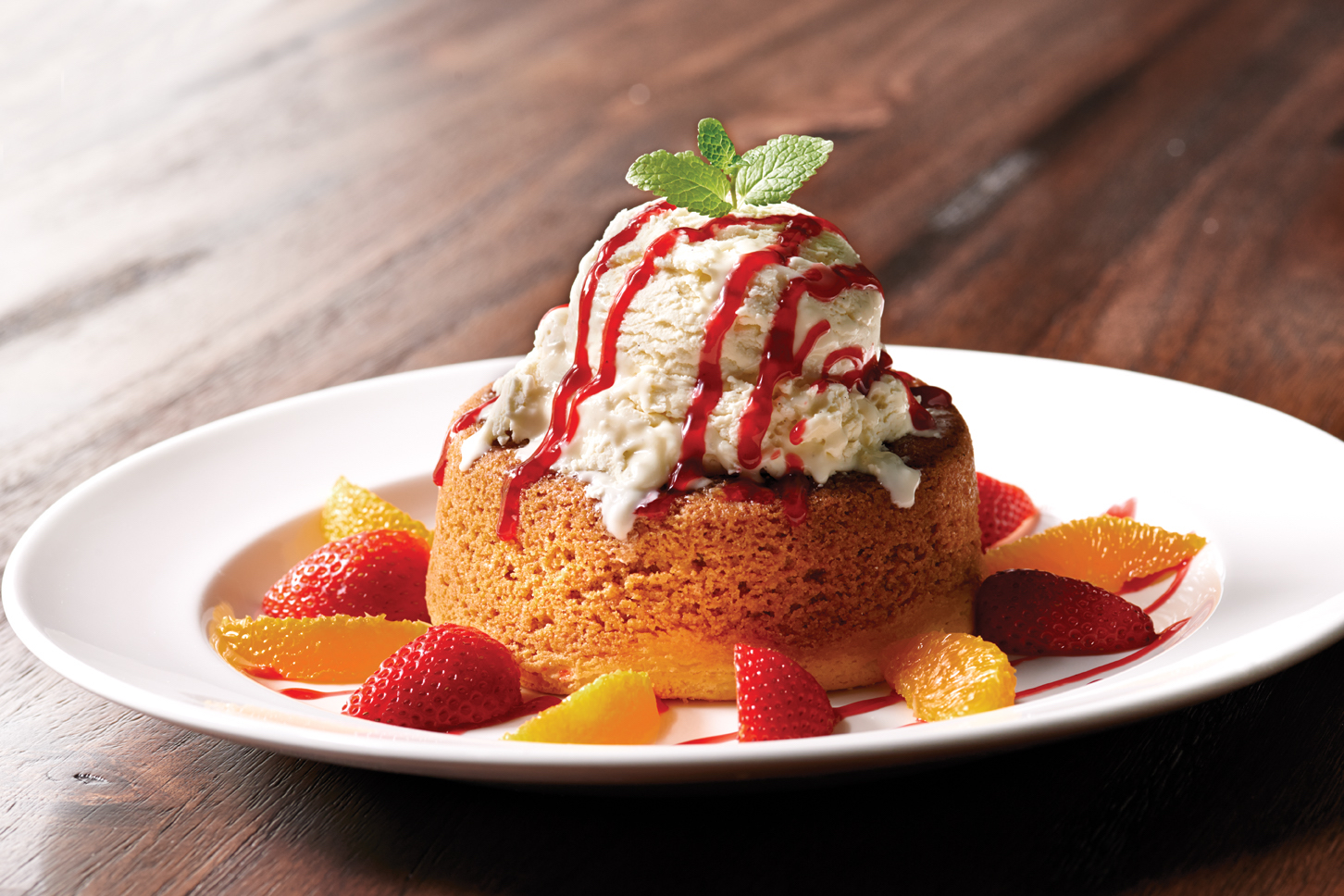 ($11)
needs a lot of work: it was gummy and dry.
($11)
needs a lot of work: it was gummy and dry.
The wine list is
impressive, if top-heavy in bottlings well above
$100, and mark-ups are high,
as they are for cocktails like the $20 martini; a
single glass of Sambuca cost $14, when a whole
bottle of the best runs about $23, and much lower
than that for a restaurant.
There is a lot to
applaud about the food and service at
Mastro’s--VIP host Victoria Hunt is only
too happy to add you to her list--and, if you
don’t mind spending a lot of money
and the cacophony (here it’s called “excitement”)
of the music, they may win
you over to their style, which is more Scottsdale
or Vegas than it is New York,
where the rubrics of the steakhouse were set
decades ago.
Mastro’s
is open for lunch Mon.-Fri.; dinner nightly.
By Brian Freedman
Champagne is one of the great wines to pair
with food at the dinner table. (Or, let’s be
honest here: The breakfast and
lunchtime tables, too.) Its combination of
acidity, minerality, fruit and
bubbles allows it to handle dishes that range
from the delicate to the hearty.
What’s less widely discussed, however, is the
ageability of great Champagne.
And that is a shame.
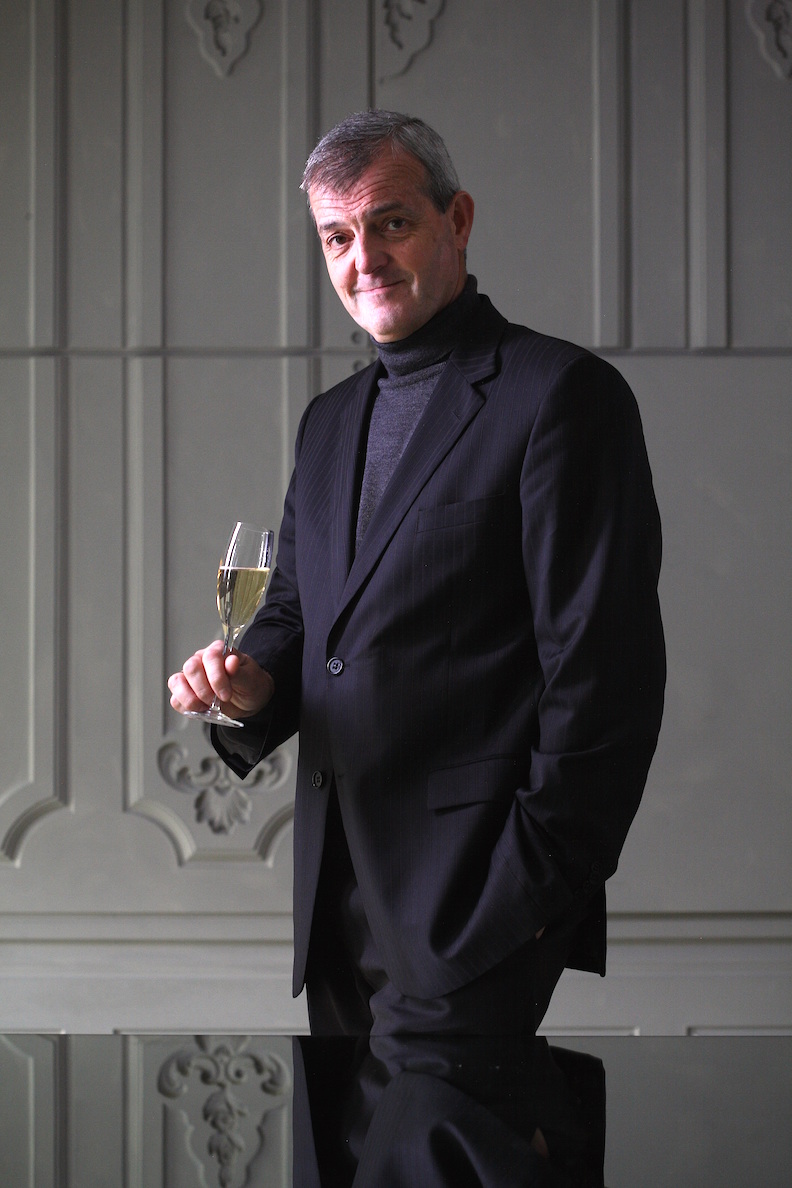 Not long ago, I had
the good
luck to be invited to an amazing tasting and
dinner, co-hosted by Régis
Camus (left)
of Champagne Piper-Heidsieck, in honor of his 20th
anniversary at the
house Since 2002 he has been Chef de Caves,
instituting changes and
ramping up quality that has resulted in an already
legendary house rising to
the level of the greats in the world. To celebrate
the occasion, the assembled
guests were treated to a once-in-a-lifetime
experience: a stunning dinner
paired with every single vintage bottling of
Piper-Heidsieck Rare Millésime—eight
of them in total, going back to 1976.
Not long ago, I had
the good
luck to be invited to an amazing tasting and
dinner, co-hosted by Régis
Camus (left)
of Champagne Piper-Heidsieck, in honor of his 20th
anniversary at the
house Since 2002 he has been Chef de Caves,
instituting changes and
ramping up quality that has resulted in an already
legendary house rising to
the level of the greats in the world. To celebrate
the occasion, the assembled
guests were treated to a once-in-a-lifetime
experience: a stunning dinner
paired with every single vintage bottling of
Piper-Heidsieck Rare Millésime—eight
of them in total, going back to 1976.
My expectations going into the evening were, of
course, high: I’ve always loved the Champagnes of
Piper-Heidsieck, and the
Chardonnay-based Rare Millésime, produced, well,
rarely—the house specifies in
its press materials that it is crafted in “those
rare years in which nature shows
an unpredictable side,” whether it’s drought
(1976), cold winters with black
frost (1985), hail storms (1999), and more. These
Champagnes are among the grandest of the region’s
têtes de cuvée. Over the course of the epic
dinner, however, my
expectations were surpassed in every way possible:
The dinner was both a de
facto master class on Champagne (Camus possesses
an encyclopedic range of
knowledge, and a passion that is thoroughly
contagious), and a deeply
rewarding and delicious tour through the many
stages of this great
wine’s potential to evolve over the decades.
The 2002 boasted aromas of mandarin orange and
passion fruit and flavors of gingerbread,
multigrain toast, and candied ginger.
It was a beguilingly exotic wine, and while it’s
excellent right now, it should
easily continue to evolve for another two decades
or more. The 1999, on the
other hand, showed lime and flowers on the nose,
as well as a pleasantly yeasty
note. This was more mature than the 2002, with its
palate of
mushrooms, dried fruit, lemon-blossom honey and
mineral. If I were fortunate
enough to have a bottle in my own cellar, I’d
drink it by 2028. But I probably
couldn’t wait that long.
Going back one year, the magnum of
1998 sang
with lemon pastry cream and gun flint, as well as
candied lemons, sandalwood,
Chinese five-spice and, as Camus pointed out,
cacao nibs and orange trees. He
also said that the magnum is the best-sized bottle
for two people, “especially
when one person doesn’t drink.” I could not agree
more, and would be thrilled
to enjoy this particular magnum on my own, between
now
and 2035.
The 1990, on the other hand, showed a
beautiful, burnished gold color in the glass. The
mature nose of persimmons,
flowers, dried porcini,
golden raisins and, as Camus pointed out, bees’
wax,
coupled with the palate of dried pineapple, baked
apple, and a finish that
lingered on with a faint memory of incense, has,
since the evening I tasted it,
become a benchmark for me when it comes to judging
mature Champagne. And, when
paired with the brilliant Swiss chard raviolo with
winter truffle, parmesan,
and heirloom squash at the dinner, it embodied the
eternal truth that great Champagne is one
of the best wines to pair with a huge range of
foods.
Heading back to the ‘80s, the 1988 reminded me
of persimmon dipped in dulce de leche, dried golden
chanterelles,
lemon, incense, and ginger. Camus said that it
spoke to him of a London or
Dublin library with its aromas of old spirits,
Armagnac, Cognac, leather, and
fireplace. He referred to it as une millésime
d’ambience, a vintage of
ambiance or atmosphere, which is a perfectly apt
description. It’s a wine that
could age for another 10 years or so, but I
wouldn’t recommend it: If you have
a bottle, drink now—the level of pleasure it
provides is game-changing.
The 1985 caused Camus to break into a joyful
smile; he declared it “extraordinaire.”
Which, indeed, it was and then
some. Aromas of preserved lemons, old paper, star
anise, Chinese five-spice,
dried passionfruit and apricots, presaged
intensely concentrated flavors of
praline and roasting coffee. Camus called it a
“rigorous, serious wine with beaucoup
de vinosité.” And, indeed, that deeply
wine-like quality was a testament to
the impeccable craftsmanship of these wines, to
the genius behind the work of
Camus himself and the amazing fruit that goes into
it.
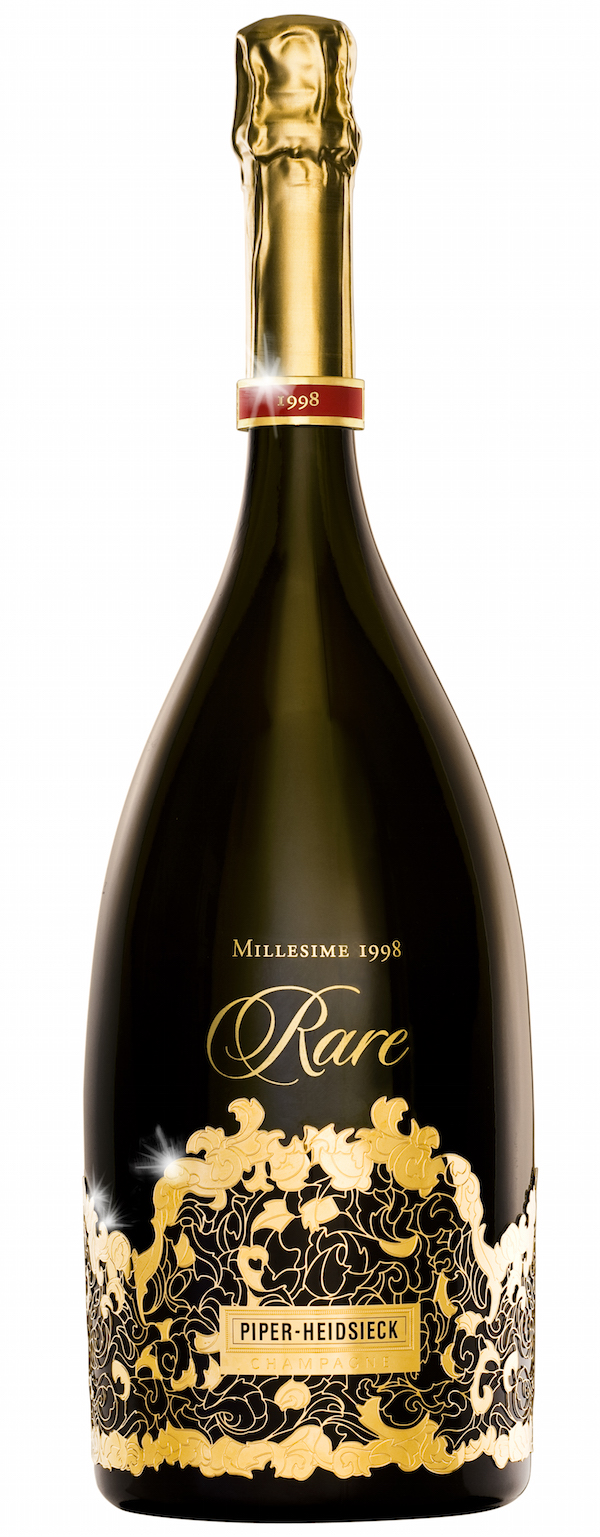 The evening finished
with two Champagnes from
the 1970s, including the 1979; it was, as he
described it, a “mythical” year for
him that resulted in wines that can still age well
in the cellar. It’s
amazingly youthful despite it age, with
laser-point bubbles carrying powerful,
vivacious flavors of mineral, passionfruit, dried
mango, Asian spice, and
sandalwood that are transporting right now, and
embody exactly how Camus summed
up the wine: “C’est la joie de vivre, le 1979.”
Indeed it is.
The evening finished
with two Champagnes from
the 1970s, including the 1979; it was, as he
described it, a “mythical” year for
him that resulted in wines that can still age well
in the cellar. It’s
amazingly youthful despite it age, with
laser-point bubbles carrying powerful,
vivacious flavors of mineral, passionfruit, dried
mango, Asian spice, and
sandalwood that are transporting right now, and
embody exactly how Camus summed
up the wine: “C’est la joie de vivre, le 1979.”
Indeed it is.
Rounding out the evening was
the 1976, of which
Camus said that there was a “very limited amount
left in the cellar, only a few
dozen bottles.” But what bottles they are, with
stunningly crisp acidity,
aromas of truffle, golden chanterelle, apple
fritters, and dried stone and
tropical fruit leading to a honeyed palate
vibrating with candied lemon peel,
almond tuille, and honeysuckle. Like all of the
vintages of Piper-Heidsieck
Rare Millésime, it was both intellectually
rewarding and deeply soulful,
possessed of both remarkable vintage
expressiveness and capable of providing
some of the most intense emotional and gustatory
pleasures that Champagne
offers.
And having the chance to do so with the man
in
charge was a once-in-a-lifetime opportunity that
not only provided context for
the wines but also an added sense of joy. If even
Régis Camus, a man who has
tasted more Champagne in his career than most us
us could in three lifetimes,
responded so viscerally to the evening—he said,
after we’d tasted the 1976, “Je
suis trés, trés touché”—well, that joy is
inevitably contagious. As well it
should be, with Champagnes as spectacular as
these.
❖❖❖
MAYBE IT'S TIME TO CHECK WHAT'S
REALLY IN THOSE "CHICKEN FINGERS"
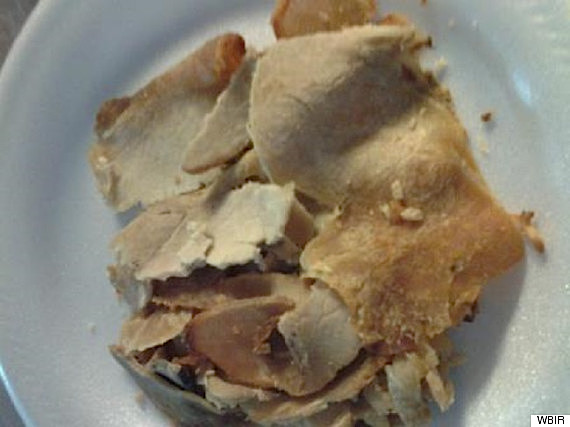
Several schools in Hawkins, TN, served its students pork (right) from a package dated 2009. "These high-schoolers -- they understand if they see something they are not going to like, they don't eat it," said Hawkins County Commissioner Michael Herrell. "But when you get to these kindergartners, first- and second-graders, do they really know if the meat is bad or not?" One school's cafeteria workers made gravy to cover up the foul taste, Herrell said. USDA guidelines recommend that frozen roasts be thrown out after four to 12 months.
 BRAVISSIMA!!!
BRAVISSIMA!!!
Italian astronaut Samantha Cristoforetti has made
the first espresso in space. Wearing her "Star
Trek" uniform, she posted a photo of herself (left) on
Twitter from the International Space Station on
Sunday, sipping from a cup designed for use in
zero-gravity. Italy's 120-year-old coffee
maestro Lavazza and the Turin-based engineering
firm Argotec teamed up on the space espresso
project with the Italian Space Agency to produce
the machine.
Anatomy of a Historic Vintage: Brunello di
Montalcino 2010
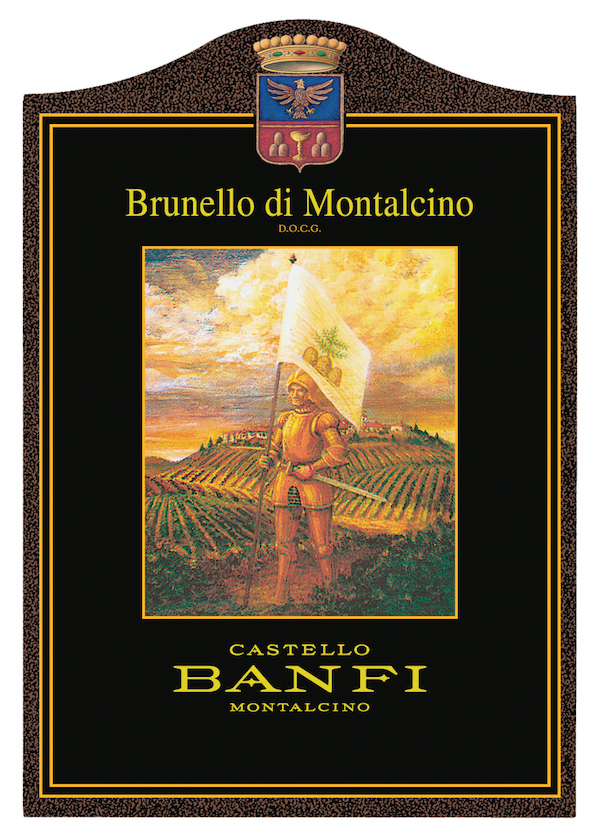 Perfect
conditions are certainly a rarity in the
unpredictable,
nature-driven world of wine. However, 2010 was a
year of near perfection in
Montalcino. This vintage was unique in that all
phases – from the vegetative
stage to the ripening and harvesting of grapes –
took place under ideal
circumstances.
Perfect
conditions are certainly a rarity in the
unpredictable,
nature-driven world of wine. However, 2010 was a
year of near perfection in
Montalcino. This vintage was unique in that all
phases – from the vegetative
stage to the ripening and harvesting of grapes –
took place under ideal
circumstances.
The year 2010 began
with copious rainfall in April that continued through
mid-June
with unseasonably cool temperatures. From then on the
climate was warm and dry
with rain returning in just the right quantity, and
without affecting the
harvest, which began later than in previous years in
early September. September
also was blessed with good diurnal swings (hot days
and cool nights) that
helped grapes to fully ripen. 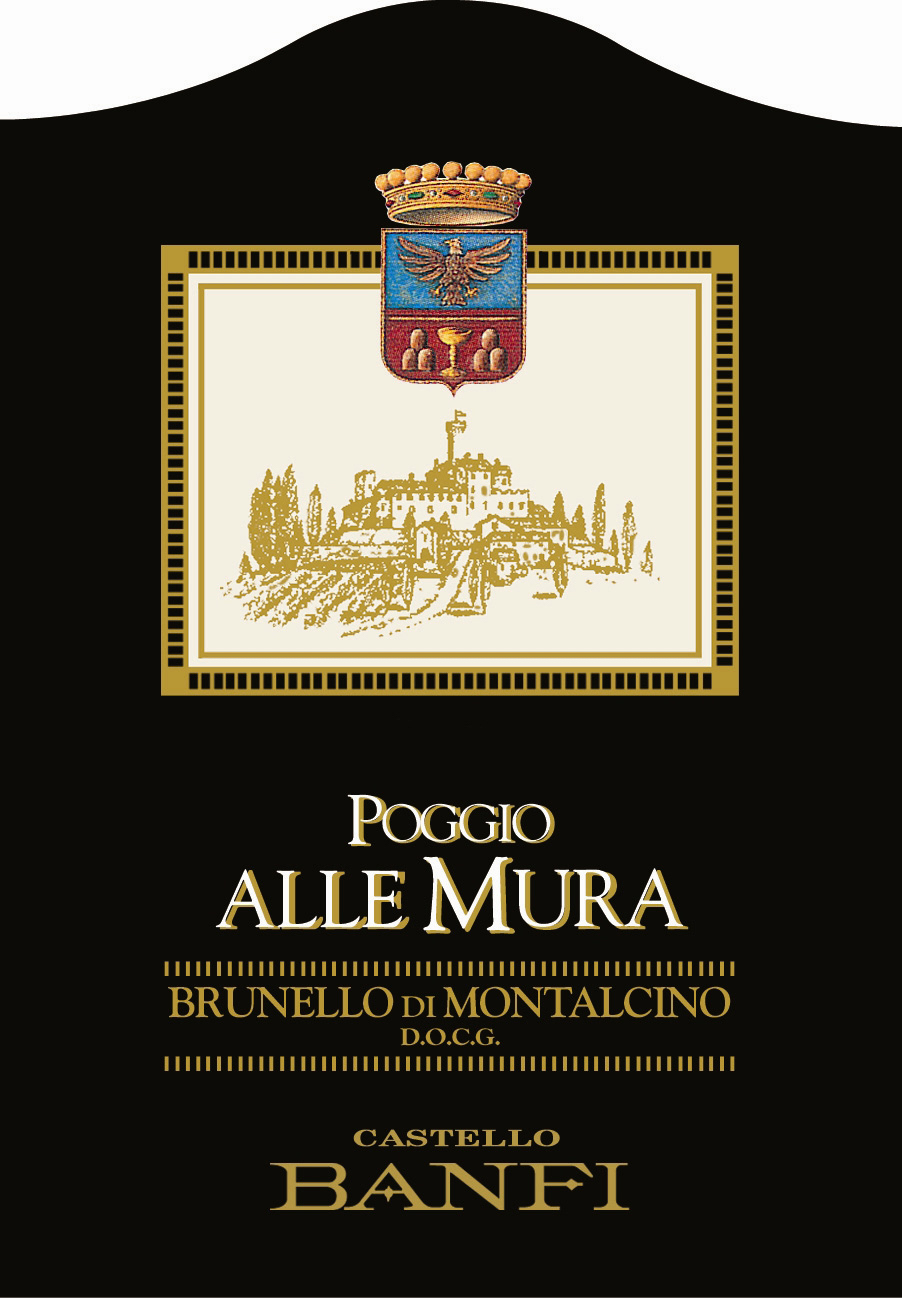 In short, vines and fruit
grew and developed
slowly and continuously throughout the season,
creating grapes with perfectly
balanced levels of sugar, acidity, and mature
polyphenols.
In short, vines and fruit
grew and developed
slowly and continuously throughout the season,
creating grapes with perfectly
balanced levels of sugar, acidity, and mature
polyphenols.
With perfect fruit,
Castello Banfi winemaker Rudy Buratti had an easy task
in making what many experts are calling the greatest
vintage in the history of
Brunello di Montalcino. “Nature did its work,” says
Buratti, “and my goal was
to carry nature’s perfection to the bottle.” Indeed he
did, as 2010 Banfi
Brunello di Montalcino normale and
Poggio alle Mura – a more complex cru
Brunello coming from Sangiovese grown in the vineyards
surrounding the estate’s
12th-century castle – are full
of vibrant, rich fruit,
excellent acidity, ripe tannins, and ample complexity.
Critics worldwide have
given high marks to both of Castello Banfi’s 2010
bottlings, assessing it a
historic vintage with long aging potential. Based in
part on its high-scoring
Brunelli, Castello Banfi was named the Winery of the
Year, Europe for 2015.
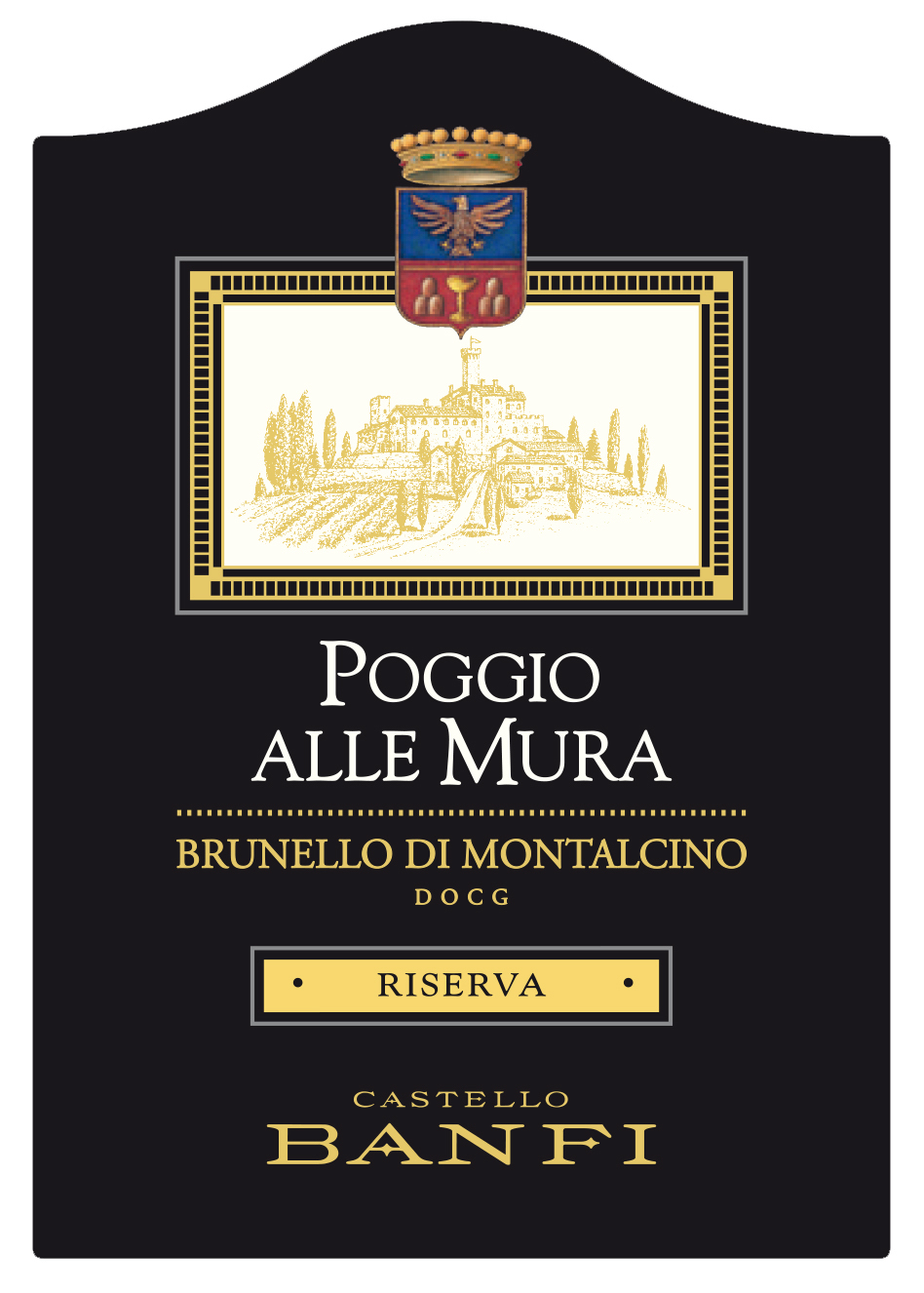 In
the US, 2010 Brunello is right now arriving – and
disappearing quickly –
from retail shelves and restaurant wine lists, so if
you want a taste (or a
case) of it, you’ll want to act sooner rather than
later. In the meantime, to
learn more about the 2010 vintage in Montalcino,
including commentary from
Castello Banfi winemaker Rudy Buratti, watch this video.
In
the US, 2010 Brunello is right now arriving – and
disappearing quickly –
from retail shelves and restaurant wine lists, so if
you want a taste (or a
case) of it, you’ll want to act sooner rather than
later. In the meantime, to
learn more about the 2010 vintage in Montalcino,
including commentary from
Castello Banfi winemaker Rudy Buratti, watch this video.
Any of John Mariani's books below may be ordered from amazon.com.
 I'm proud and happy to announce that my
new book, The Hound
in Heaven (21st Century Lion Books), has just
been published through Amazon and Kindle.
I'm proud and happy to announce that my
new book, The Hound
in Heaven (21st Century Lion Books), has just
been published through Amazon and Kindle. It is a novella, and for anyone who loves dogs, Christmas, romance, inspiration, even the supernatural, I hope you'll find this to be a treasured favorite. The story concerns how, after a New England teacher, his wife and their two daughters adopt a stray puppy found in their barn in northern Maine, their lives seem full of promise. But when tragedy strikes, their wonderful dog Lazarus and the spirit of Christmas are the only things that may bring back his master back from the edge of despair.
WATCH THE VIDEO!
“What a huge surprise turn this story took! I was completely stunned! I truly enjoyed this book and its message.” – Actress Ali MacGraw
“He had me at Page One. The amount of heart, human insight, soul searching, and deft literary strength that John Mariani pours into this airtight novella is vertigo-inducing. Perhaps ‘wow’ would be the best comment.” – James Dalessandro, author of Bohemian Heart and 1906.
“John Mariani’s Hound in Heaven starts with a well-painted portrayal of an American family, along with the requisite dog. A surprise event flips the action of the novel and captures us for a voyage leading to a hopeful and heart-warming message. A page turning, one sitting read, it’s the perfect antidote for the winter and promotion of holiday celebration.” – Ann Pearlman, author of The Christmas Cookie Club and A Gift for my Sister.
“John Mariani’s concise, achingly beautiful novella pulls a literary rabbit out of a hat – a mash-up of the cosmic and the intimate, the tragic and the heart-warming – a Christmas tale for all ages, and all faiths. Read it to your children, read it to yourself… but read it. Early and often. Highly recommended.” – Jay Bonansinga, New York Times bestselling author of Pinkerton’s War, The Sinking of The Eastland, and The Walking Dead: The Road To Woodbury.
“Amazing things happen when you open your heart to an animal. The Hound in Heaven delivers a powerful story of healing that is forged in the spiritual relationship between a man and his best friend. The book brings a message of hope that can enrich our images of family, love, and loss.” – Dr. Barbara Royal, author of The Royal Treatment.
 |
The Encyclopedia of American Food and Drink by John F. Mariani (Bloomsbury USA, $35) Modesty forbids me to praise my own new book, but let me proudly say that it is an extensive revision of the 4th edition that appeared more than a decade ago, before locavores, molecular cuisine, modernist cuisine, the Food Network and so much more, now included. Word origins have been completely updated, as have per capita consumption and production stats. Most important, for the first time since publication in the 1980s, the book includes more than 100 biographies of Americans who have changed the way we cook, eat and drink -- from Fannie Farmer and Julia Child to Robert Mondavi and Thomas Keller. "This book is amazing! It has entries for everything from `abalone' to `zwieback,' plus more than 500 recipes for classic American dishes and drinks."--Devra First, The Boston Globe. "Much needed in any kitchen library."--Bon Appetit. |
"Eating Italian will never be the same after reading John Mariani's entertaining and savory gastronomical history of the cuisine of Italy and how it won over appetites worldwide. . . . This book is such a tasteful narrative that it will literally make you hungry for Italian food and arouse your appetite for gastronomical history."--Don Oldenburg, USA Today. "Italian
restaurants--some good, some glitzy--far
outnumber their French rivals. Many of
these establishments are zestfully described
in How Italian Food Conquered the World, an
entertaining and fact-filled chronicle by
food-and-wine correspondent John F.
Mariani."--Aram Bakshian Jr., Wall Street
Journal.
"Equal parts
history, sociology, gastronomy, and just
plain fun, How Italian Food Conquered the
World tells the captivating and delicious
story of the (let's face it) everybody's
favorite cuisine with clarity, verve and
more than one surprise."--Colman Andrews,
editorial director of The Daily
Meal.com. "A fantastic and fascinating
read, covering everything from the influence
of Venice's spice trade to the impact of
Italian immigrants in America and the
evolution of alta cucina. This book will
serve as a terrific resource to anyone
interested in the real story of Italian
food."--Mary Ann Esposito, host of PBS-TV's
Ciao
Italia. "John Mariani has written the
definitive history of how Italians won their
way into our hearts, minds, and
stomachs. It's a story of pleasure over
pomp and taste over technique."--Danny Meyer,
owner of NYC restaurants Union Square
Cafe, The Modern, and Maialino.
|
 |
 |
 |
 |
 |
 |
 |
 |
 Everett Potter's Travel Report:
Everett Potter's Travel Report: 
 Eating Las
Vegas is the new on-line site for
Virtual Gourmet contributor John A. Curtas.,
who since 1995 has been commenting on the
Las Vegas food scene and reviewing
restaurants for Nevada Public Radio.
He is also the restaurant critic for KLAS
TV, Channel 8 in Las Vegas, and his past
reviews can be accessed at KNPR.org.
Click on the logo below to go directly to
his site.
Eating Las
Vegas is the new on-line site for
Virtual Gourmet contributor John A. Curtas.,
who since 1995 has been commenting on the
Las Vegas food scene and reviewing
restaurants for Nevada Public Radio.
He is also the restaurant critic for KLAS
TV, Channel 8 in Las Vegas, and his past
reviews can be accessed at KNPR.org.
Click on the logo below to go directly to
his site.

Tennis Resorts Online: A Critical Guide to the World's Best Tennis Resorts and Tennis Camps, published by ROGER COX, who has spent more than two decades writing about tennis travel, including a 17-year stretch for Tennis magazine. He has also written for Arthur Frommer's Budget Travel, New York Magazine, Travel & Leisure, Esquire, Money, USTA Magazine, Men's Journal, and The Robb Report. He has authored two books-The World's Best Tennis Vacations (Stephen Greene Press/Viking Penguin, 1990) and The Best Places to Stay in the Rockies (Houghton Mifflin, 1992 & 1994), and the Melbourne (Australia) chapter to the Wall Street Journal Business Guide to Cities of the Pacific Rim (Fodor's Travel Guides, 1991).


MARIANI'S VIRTUAL GOURMET
NEWSLETTER is published weekly. Editor/Publisher: John
Mariani.
Editor: Walter Bagley. Contributing Writers: Christopher Mariani,
Robert Mariani, Misha
Mariani,
John A. Curtas, Edward Brivio, Mort Hochstein,
Andrew Chalk, Dotty Griffith and Brian Freedman. Contributing
Photographers: Galina Dargery, Bobby
Pirillo. Technical Advisor: Gerry McLoughlin.
To un-subscribe from this newsletter,click here.
© copyright John Mariani 2015

